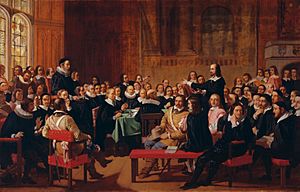List of members of the Westminster Assembly facts for kids
The Westminster Divines were a group of important religious leaders and thinkers. They met a long time ago, in the 1600s, in a place called the Westminster Assembly. Their main job was to create new rules and beliefs for the Church of England. This meeting happened during a very busy time in English history, when the country was going through big changes.
The English Parliament, a group of lawmakers, decided to start this Assembly. They chose 121 ministers from the Church of England to be part of it. These ministers were the main "Divines." But it wasn't just ministers! The Parliament also invited 30 regular people, called "lay assessors," to join. These included 10 nobles (important lords) and 20 commoners (regular citizens). Six special representatives from the Church of Scotland also came to help.
Not everyone who was invited actually showed up. About 25 ministers never took their seats. So, Parliament added 21 more ministers to replace those who didn't come, or who had become sick or passed away. These new additions were sometimes called the "Superadded Divines." Some people, known as Royalists, didn't join because King Charles I told his supporters not to take part in the Assembly.
Contents
Who Were the Westminster Divines?
The Westminster Assembly was made up of different kinds of people. They all had a role in shaping the new religious ideas.
English and Welsh Clergy
Most of the members were ministers from England and Wales. They were experts in religious matters and spent years discussing and writing the new rules. Some famous names included John Arrowsmith, a master of a college in Cambridge, and Thomas Goodwin, a very influential preacher. These ministers came from all over the country, bringing different ideas and experiences to the Assembly.
Lay Assessors: Nobles and Commoners
Besides the clergy, there were also "lay assessors." These were not ministers but important people from Parliament. They helped make sure the new religious rules would work for everyone in society.
Nobles Who Participated
Some of the most powerful people in England, like the Earl of Salisbury and the Earl of Pembroke, were part of this group. Their presence showed how important the Assembly was to the country's future.
Commoners Who Participated
Regular citizens who were members of the House of Commons also joined. They represented the everyday people of England. One notable member was John Pym, a very important leader in Parliament at the time.
Scottish Commissioners
The Church of Scotland also sent its own representatives, called "Commissioners." They were invited because Scotland and England were working together during this period. They wanted to make sure the new religious beliefs would be similar in both countries.
Scottish Ministers
Key Scottish ministers like Robert Baillie and Samuel Rutherford were very active in the Assembly. They brought their strong Presbyterian beliefs, which influenced many of the decisions made.
Scottish Elders
Important Scottish nobles and leaders, such as Archibald Campbell, also served as elders. They helped represent Scotland's interests and views during the discussions.
What Did They Do?
The main goal of the Westminster Assembly was to create a new set of religious documents. The most famous of these is the Westminster Confession of Faith. This document explained what the Church believed and how it should be run. They also wrote catechisms, which are like question-and-answer guides to Christian beliefs, to help people learn. The work of the Divines had a huge impact on the history of Christianity, especially for Presbyterian churches around the world.
Images for kids



